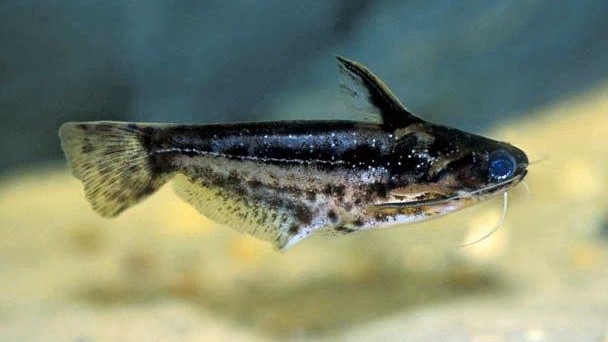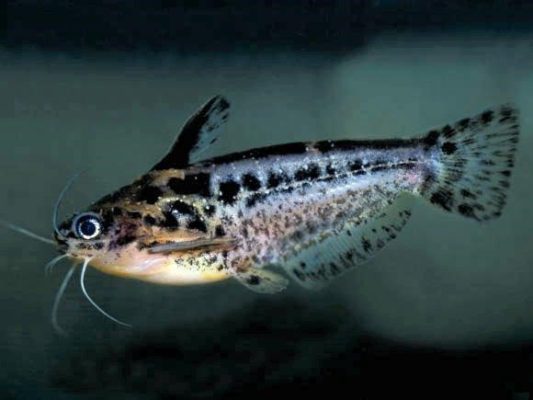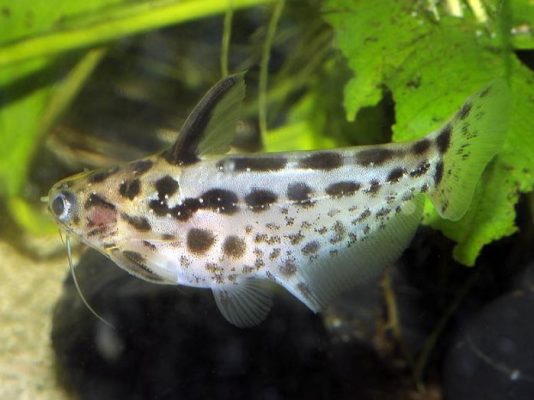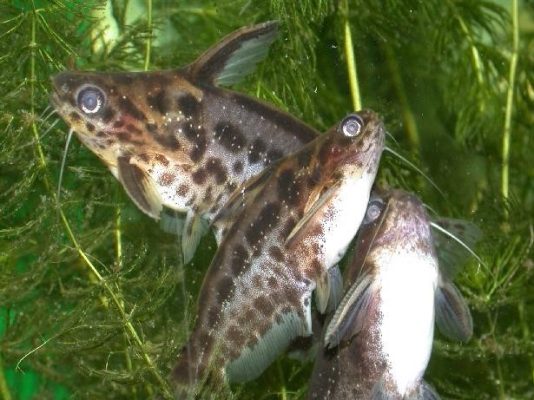Pygmy Driftwood Catfish

Table of Contents
- Introduction
- Taxonomy and Classification
- Physical Description
- Behavior and Reproduction
- Importance in the Aquarium Trade
- Conclusion
Introduction
The pygmy driftwood catfish, scientifically known as Trachelyichthys exilis, is a fascinating species of fish that has captured the attention of aquarium enthusiasts worldwide. This small catfish, measuring only a few centimeters in length, is native to the rivers and streams of South America. Its unique characteristics and intriguing behavior make it a sought-after addition to aquariums.
Studying and understanding the pygmy driftwood catfish is of great importance for several reasons. Firstly, it allows us to gain insights into the intricate workings of freshwater ecosystems and the role this species plays within them. By studying its behavior, feeding habits, and interactions with other fish, we can better comprehend the dynamics of aquatic communities.
Furthermore, understanding the pygmy driftwood catfish contributes to our knowledge of fish biology and ecology. This species possesses unique physical features and adaptations that have evolved over time, allowing it to thrive in its natural habitat. By studying these adaptations, we can gain valuable insights into the evolutionary processes that shape fish species.
The pygmy driftwood catfish has gained immense popularity among aquarium enthusiasts due to its small size, striking appearance, and interesting behavior. Its vibrant coloration, which ranges from shades of orange to brown, adds a captivating element to any aquarium. Additionally, its peaceful nature and compatibility with a variety of tank mates make it a sought-after choice for community tanks.
Aquarists are drawn to the pygmy driftwood catfish not only for its aesthetic appeal but also for its ability to contribute to a balanced and healthy aquarium ecosystem. These catfish are known for their algae-eating habits, helping to control excessive algae growth in the tank. This natural behavior makes them a valuable addition to any aquarist’s collection.
This guide aims to provide aquarists with comprehensive information on the care and tank setup required for the pygmy driftwood catfish. By offering detailed insights into their habitat, behavior, feeding habits, and reproduction, this guide will equip enthusiasts with the knowledge necessary to create a suitable and thriving environment for these captivating fish.
Additionally, this guide will provide guidance on maintaining optimal water conditions, including temperature, pH levels, and water quality, to ensure the health and well-being of the pygmy driftwood catfish. It will also offer tips on tank decoration, hiding spots, and suitable tank mates to create a harmonious and stimulating environment for these fish.
By following the recommendations and guidelines outlined in this guide, aquarists will be able to provide the best possible care for their pygmy driftwood catfish and witness the beauty and charm of these remarkable creatures in their own aquariums.
Taxonomy and Classification
The pygmy driftwood catfish, scientifically known as Trachelyichthys exilis, belongs to the Animal Kingdom, specifically the Phylum Chordata. Within the Chordata phylum, it falls under the Class Actinopterygii, which includes ray-finned fishes.
In terms of its phylogenetic relationships with other catfish species, the pygmy driftwood catfish belongs to the family Auchenipteridae, commonly known as driftwood catfishes. This family comprises approximately 80 species, and the pygmy driftwood catfish is one of the smallest members.
Unique Characteristics
What sets the pygmy driftwood catfish apart from other catfish species is its unique set of characteristics.
- Slender and Elongated Body: The pygmy driftwood catfish possesses a slender and elongated body, enabling it to navigate through narrow spaces and seek refuge in driftwood or vegetation. This adaptation allows the catfish to avoid predators and find suitable hiding spots.
- Intricate Coloration Pattern: The catfish displays a remarkable coloration pattern on its body. It typically has a dark brown or black base color, adorned with intricate markings of lighter shades. These markings often resemble the patterns found on driftwood, providing the catfish with effective camouflage in its natural habitat.
- Ventral Mouth: Another distinguishing feature of the pygmy driftwood catfish is its ventral mouth, positioned on the underside of its head. This adaptation allows it to feed on small invertebrates and detritus that accumulate on the riverbed or within the driftwood. The catfish uses its specialized mouth to scrape off food particles and extract nutrients efficiently.
- Respiratory Adaptation: Furthermore, the pygmy driftwood catfish possesses a unique respiratory adaptation known as accessory breathing organs. These organs, located behind its gills, allow the catfish to extract oxygen from the air when oxygen levels in the water are low. This adaptation enables the catfish to survive in oxygen-deprived environments, such as stagnant pools or during dry seasons.
In summary, the pygmy driftwood catfish, scientifically named Trachelyichthys exilis, belongs to the Class Actinopterygii within the Animal Kingdom. It is a member of the family Auchenipteridae, which comprises driftwood catfishes. The species is characterized by its slender body, intricate coloration patterns, ventral mouth, and respiratory adaptation. These unique features contribute to its ability to thrive in its natural habitat and make it a fascinating subject for further study and understanding.
Physical Description
Size and Shape of the Pygmy Driftwood Catfish
The pygmy driftwood catfish, scientifically known as Trachelyichthys exilis, is a small species of catfish that typically reaches a maximum size of 1.5 inches (3.8 cm) in length. Its body is elongated and slender, with a cylindrical shape that allows it to navigate through narrow spaces and crevices in its natural habitat. Despite its small size, this catfish possesses remarkable agility and flexibility, enabling it to maneuver effortlessly among driftwood and vegetation.
Coloration and Patterns on its Body
The pygmy driftwood catfish exhibits a striking coloration that adds to its allure. Its body is predominantly dark brown or black, providing excellent camouflage in its natural environment. Along its sides, there are iridescent silver or gold speckles that shimmer when light hits them, creating a mesmerizing effect. These speckles serve as a form of disruptive coloration, breaking up the fish’s outline and making it harder for predators to spot.
Additionally, the pygmy driftwood catfish has a series of vertical bars that run along its body, starting from its dorsal fin and extending towards its ventral region. These bars are typically a lighter shade of brown or tan, providing further camouflage against the dappled light that filters through the aquatic vegetation in its habitat. The combination of these coloration patterns and speckles not only enhances its beauty but also aids in its survival by blending seamlessly with its surroundings.
Unique Physical Features or Adaptations that Aid in its Survival
The pygmy driftwood catfish possesses several unique physical features and adaptations that contribute to its survival in its natural habitat.
- One notable adaptation is its ventral mouth, which is positioned on the underside of its head. This mouth orientation allows the catfish to feed on fallen debris, detritus, and small invertebrates that accumulate on the riverbed or among the driftwood. By utilizing this feeding strategy, the pygmy driftwood catfish plays a crucial role in maintaining the ecological balance of its habitat by recycling organic matter and preventing the accumulation of waste.
- Furthermore, the catfish has well-developed pectoral fins that aid in its ability to navigate through the dense vegetation and tight spaces within its environment. These fins are flexible and possess a high degree of maneuverability, enabling the catfish to swim effortlessly among the intricate network of roots and branches of submerged driftwood. This adaptability allows the pygmy driftwood catfish to access hidden food sources and find shelter from potential predators.
- Additionally, the catfish has a specialized organ called the Weberian apparatus, which enhances its hearing capabilities. This organ consists of a series of small bones that connect the inner ear to the swim bladder, enabling the catfish to detect subtle vibrations and sound waves in the water. This heightened sense of hearing helps the pygmy driftwood catfish locate potential prey, communicate with conspecifics, and detect the presence of predators, thereby increasing its chances of survival.
In conclusion, the pygmy driftwood catfish is a fascinating species with unique physical characteristics. Its small size, elongated shape, and camouflage coloration allow it to navigate through narrow spaces and blend seamlessly with its environment. Its ventral mouth, well-developed pectoral fins, and specialized hearing organ further contribute to its survival and success in its natural habitat. Understanding and appreciating these physical attributes not only adds to our knowledge of this species but also highlights the incredible diversity and adaptability of catfish in general.
Habitat and Distribution
Natural Habitat and Distribution
The pygmy driftwood catfish, scientifically known as Trachelyichthys exilis, primarily inhabits the freshwater rivers and streams of South America. This species is native to the Amazon River basin, specifically in Brazil, Colombia, Peru, and Venezuela. Within these regions, they are commonly found in slow-moving or stagnant water bodies, including tributaries and flooded areas.
These catfish are well adapted to the unique environmental conditions of their natural habitat. They are commonly found in areas with dense vegetation, such as flooded forests and swamps, where they seek shelter and forage for food. The pygmy driftwood catfish is known to inhabit areas with an abundance of submerged driftwood, fallen branches, and leaf litter, which provide them with hiding places and mimic their natural environment.
Preferred Water Conditions
To ensure the optimal health and well-being of the pygmy driftwood catfish in captivity, it is crucial to replicate their natural habitat conditions as closely as possible. These fish thrive in warm, tropical waters with stable water parameters.
The ideal temperature range for the pygmy driftwood catfish is between 75°F and 82°F (24°C – 28°C). Maintaining a consistent temperature within this range is essential for their overall health and metabolic functions. It is recommended to use a reliable aquarium heater to regulate the water temperature and prevent any sudden fluctuations.
In terms of pH levels, the pygmy driftwood catfish prefers slightly acidic to neutral water conditions. A pH range of 6.0 to 7.5 is suitable for their well-being. It is important to regularly test the water parameters using a reliable pH testing kit and make necessary adjustments using appropriate buffering agents if needed.
Furthermore, these catfish are sensitive to poor water quality, so it is crucial to maintain excellent water filtration and perform regular water changes to keep ammonia, nitrite, and nitrate levels in check. Providing a well-oxygenated environment through the use of a quality air pump or efficient water movement is also essential for their overall health.
Geographical Distribution and Range
The pygmy driftwood catfish has a relatively wide geographical distribution within the Amazon River basin. They can be found in various regions of Brazil, including the Amazonas, Pará, and Amapá states. In Colombia, they are present in the Amazonas, Caquetá, and Putumayo departments. In Peru, they can be found in Loreto, Ucayali, and Madre de Dios, while in Venezuela, they inhabit the Amazonas state.
It is worth noting that the pygmy driftwood catfish has not been reported in any other parts of the world outside the Amazon River basin. This restricted distribution makes them a unique and sought-after species among aquarium enthusiasts.
In conclusion, the pygmy driftwood catfish is a fascinating species that thrives in the freshwater rivers and streams of the Amazon River basin. Understanding their natural habitat, preferred water conditions, and geographical distribution is crucial for successfully keeping them in captivity and contributing to their conservation. By replicating their natural environment and providing optimal care, we can ensure the well-being and longevity of this remarkable species.
Behavior and Reproduction
Feeding habits and diet preferences of the pygmy driftwood catfish
The pygmy driftwood catfish, Trachelyichthys exilis, is a fascinating species with unique feeding habits and diet preferences. As an omnivorous fish, it has a diverse diet that consists of both plant matter and small invertebrates.
In its natural habitat, the pygmy driftwood catfish feeds on algae, detritus, small insects, and other organic matter found on submerged driftwood and vegetation. It uses its specially adapted mouthparts to scrape and graze on these surfaces, extracting nutrients and microorganisms.
In an aquarium setting, it is essential to replicate their natural feeding behavior to ensure their optimal health and well-being. Providing a varied diet is crucial for these catfish. High-quality commercial fish foods such as sinking pellets or flakes specifically formulated for bottom-dwelling species can be offered as a staple diet. Additionally, supplementing their diet with live or frozen foods like bloodworms, daphnia, brine shrimp, and finely chopped vegetables will provide essential nutrients and mimic their natural feeding habits.
It is important to note that overfeeding should be avoided, as it can lead to health issues and water quality problems. Feeding small amounts multiple times a day is recommended, ensuring that the food is consumed within a few minutes.
Social behavior and interactions with other fish in the aquarium
The pygmy driftwood catfish is known for its peaceful and social nature, making it an excellent addition to community aquariums. They are generally non-aggressive and coexist well with other small, peaceful fish species.
These catfish are primarily bottom-dwellers and spend a significant amount of time exploring and foraging in the substrate. They are often seen swimming near driftwood or hiding among plants, creating a sense of security.
While they are generally peaceful, it is important to consider their small size and delicate nature when selecting tankmates. Avoid keeping them with larger, aggressive fish that may pose a threat or outcompete them for food. Suitable tankmates include small tetras, rasboras, guppies, and other peaceful community fish that share similar water parameter requirements.
Observing their social behavior can be a delight, as they engage in shoaling behavior and form small groups. They are known to exhibit interesting interactions with their own species and other bottom-dwelling fish, such as playful chasing or occasional territorial disputes. Providing ample hiding places, such as caves or dense vegetation, will help create territories and reduce any potential aggression.
Breeding behavior and reproductive strategies employed by this species
Breeding the pygmy driftwood catfish in captivity can be a rewarding experience for dedicated aquarists. While they have been successfully bred in home aquariums, reproducing them can be challenging due to their specific breeding requirements.
To initiate breeding, it is crucial to create optimal conditions that mimic their natural habitat. This includes providing suitable water parameters, such as slightly acidic to neutral pH (6.5-7.5), soft to moderately hard water, and maintaining a stable temperature around 78-82°F (25-28°C). Additionally, the presence of driftwood, plants, and hiding spots will help simulate their natural spawning environment.
During courtship, the male pygmy driftwood catfish will display vibrant colors and engage in elaborate mating rituals to attract the female. The female will lay adhesive eggs on the underside of driftwood or plant leaves, and the male will fertilize them. It is important to provide suitable surfaces for the eggs to adhere to, as they are known to be adhesive spawners.
After spawning, it is advisable to remove the adult fish from the breeding tank to prevent them from consuming the eggs. The eggs typically hatch within a few days, and the fry will initially feed on their yolk sacs. Once the fry become free-swimming, they can be fed infusoria, newly hatched brine shrimp, or commercially available liquid fry food.
Breeding the pygmy driftwood catfish requires patience, attention to detail, and a well-prepared breeding setup. It is recommended to research specific breeding techniques and seek guidance from experienced breeders to increase the chances of successful reproduction.
By understanding the feeding habits, social behavior, and breeding strategies of the pygmy driftwood catfish, aquarists can provide optimal care and create a thriving environment for these captivating fish.
Importance in the Aquarium Trade
Popularity and demand among aquarium enthusiasts
The pygmy driftwood catfish, Trachelyichthys exilis, has gained significant popularity among aquarium enthusiasts in recent years. This small, charismatic fish has captured the attention of hobbyists due to its unique appearance, interesting behavior, and ease of care. Its diminutive size and peaceful nature make it a perfect addition to both beginner and experienced aquarists’ tanks.
The pygmy driftwood catfish’s popularity can be attributed to its striking coloration and patterns. With a sleek body covered in a combination of dark brown and black markings, this species stands out in any aquarium. The contrast between its dark body and the vibrant orange or yellow fins creates a visually appealing display that captivates onlookers.
Suitability for different tank setups and community tanks
One of the reasons why the pygmy driftwood catfish has become highly sought after is its adaptability to various tank setups. This species thrives in both small and large aquariums, making it suitable for hobbyists with limited space. Its small size, typically reaching only 1.5 inches in length, allows for a comfortable and visually pleasing display in nano tanks.
The pygmy driftwood catfish is also known for its peaceful nature, making it an excellent addition to community tanks. It coexists harmoniously with a wide range of fish species, including tetras, rasboras, and dwarf cichlids. However, caution should be exercised when choosing tankmates, as larger or aggressive fish may intimidate or prey upon the pygmy driftwood catfish.
Provide care and maintenance tips for keeping pygmy driftwood catfish in captivity
To ensure the well-being of pygmy driftwood catfish in captivity, it is crucial to replicate their natural habitat as closely as possible. These fish originate from slow-moving rivers and streams with dense vegetation, so providing ample hiding spots and driftwood in the aquarium is essential. Live plants, such as Java moss or Anubias, can also be added to create a natural environment and offer additional hiding places.
Maintaining suitable water conditions is vital for the health of pygmy driftwood catfish. They prefer slightly acidic to neutral water with a pH range of 6.5 to 7.5. The temperature should be kept between 72°F and 78°F (22°C to 26°C). Regular water changes and filtration are necessary to maintain optimal water quality and prevent the buildup of harmful substances.
In terms of diet, pygmy driftwood catfish are omnivorous and will readily accept a variety of foods. A balanced diet should consist of high-quality flake or pellet food supplemented with live or frozen foods such as bloodworms, brine shrimp, and daphnia. It is recommended to feed them small portions multiple times a day to mimic their feeding habits in the wild.
It is important to note that pygmy driftwood catfish are sensitive to sudden changes in water parameters. Therefore, acclimating them slowly to their new environment and avoiding drastic changes in temperature or water chemistry is crucial for their well-being.
In conclusion, the pygmy driftwood catfish has gained popularity among aquarium enthusiasts due to its unique appearance, peaceful nature, and adaptability to various tank setups. By providing suitable hiding spots, driftwood, and maintaining optimal water conditions, hobbyists can successfully keep and enjoy these captivating fish in their aquariums. Remember to research and seek expert advice to ensure the best care for your pygmy driftwood catfish and create a thriving aquatic environment.
Conclusion
In conclusion, the pygmy driftwood catfish, scientifically known as Trachelyichthys exilis, is a fascinating species that deserves our attention and study. Throughout this article, we have explored various aspects of this catfish, from its taxonomy and physical description to its habitat, behavior, and conservation status.
To recap, the pygmy driftwood catfish is a small-sized fish with unique physical features, such as its elongated body and intricate coloration. It is primarily found in rivers and streams of South America, requiring specific water conditions to thrive. This species exhibits interesting feeding habits and social behaviors, and its breeding strategies are worth further exploration.
However, the pygmy driftwood catfish faces numerous threats to its survival. Human impacts, including habitat destruction and pollution, have significantly affected its population. Recognizing the importance of conservation efforts is crucial to protect this species and its natural habitat.
The popularity and demand for the pygmy driftwood catfish among aquarium enthusiasts highlight its significance in the aquarium trade. Its adaptability to different tank setups and compatibility with other fish make it a desirable choice for many hobbyists. However, providing proper care and maintenance is essential to ensure their well-being in captivity.
Scientific studies conducted on the pygmy driftwood catfish have contributed valuable insights into fish biology and ecology. These studies have shed light on its unique characteristics and behavior, but there are still unanswered questions that warrant further research.
In conclusion, continued research and conservation efforts are vital for the long-term survival of the pygmy driftwood catfish. By understanding its biology, behavior, and habitat requirements, we can work towards preserving this species and its ecosystem. It is important for readers to explore further resources and seek expert advice for any specific concerns related to the care and conservation of the pygmy driftwood catfish.
Together, we can ensure that this remarkable species continues to thrive and enrich our understanding of the diverse world of aquatic life.



